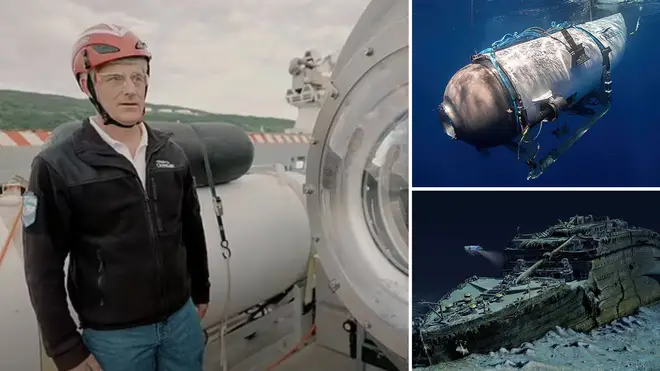
Paul Brand 10am - 12pm
22 June 2023, 14:39 | Updated: 22 June 2023, 14:56

The boss of the fateful OceanGate submarine previously spoke about ‘breaking rules’ in the craft’s construction.
The deep sea vessel’s air supply is now estimated to have run out as the desperate search for it continues.
In a video posted to YouTube last year Stockton Rush, OceanGate CEO, told Mexican actor Alan Estrada about the sub’s seven-inch thick acrylic window - the only way to gaze out onto the wreck of the Titanic.
He said the window gets ‘squeezed’ as the craft gets down to 12,500 feet below the surface. If it is going to fail, the structure gives a ‘warning,’ he says in the video.
But Rush admits in the clip he had “broken some rules to make this.”
Asked what the window is made from, he says: “It’s acrylic - plexiglass.

“It is seven inches thick and weighs about 80lbs. When we go to the titanic it will squeeze in about three-quarters of an inch and just deforms.
“Acrylic is great because before it cracks or fails it starts to crackle so you get a huge warning if it’s about to fail.”
Some experts believe the craft may have suffered a catastrophic failure due to the pressure underwater - with the window being a possible area of concern.
“The sub is your vehicle to get there. It should be an elevator, it should not be an exercise in buttons and switches and stuff,” he says.
@CoastGuardCAN Ann Harvey and Motor Vessel Horizon Arctic (ROV) have arrived on scene and are conducting search patterns in search of submersible, Titan. #Titanic pic.twitter.com/sg96QCaMzD
— USCGNortheast (@USCGNortheast) June 22, 2023
He tells the actor: “I’ve broken some rules to make this.
“I think I broke them with logic and good engineering behind me. The carbon and firmer and titanium, there’s a rule you don’t do that - well I did.
“There’s picking the rules that you break that are the rules that will add value to others and add value to society, and that really to me is about innovation.”
Experts have explained how the missing submersible would be moved if found at the bottom of the sea, as hopes for a rescue diminish.

United States Coast Guard make statement about ongoing search for Titan
A Q&A panel conceded that the search for the Titan vessel, which went missing during a voyage to the Titanic wreck site, is "running out of time" and "doesn't look good".
They also questioned the "speculative" source of the underwater noises that have been detected by rescue crafts and predicted that the incident will trigger an investigation into how deep-sea activities are regulated in the future.
The Q&A heard that the Titan will need to be located, brought to the surface if it is on the sea bed and then would need to be unsealed from the outside.
It was indicated surfacing would take around two hours.
British Antarctic Survey marine geophysicist Dr Rob Larter said: "It is incredibly difficult to find an object of this sort of size at the bottom of the ocean.
"You are talking about a totally dark environment.
"You are not going to be able to find this with active sonar from a surface ship.
"You're going to have to have some sort of deep-towed or autonomous vehicle that's roaming around nearer the sea floor."
He added that the Victor 6000 remotely operated vehicle (ROV) is, he believes, the "only thing" that is on site with the capability to get down to the sea bed and explore.
Prof Greig said the ROV will not be able to lift the Titan itself and will have to attach "some device" to it.
He speculated that if Titan is trapped under debris then the ROV's "manipulator arms" may be able to free it for the submersible to then make its own way up.
The US Coast Guard announced on Wednesday that underwater noises had been detected in the search area.
Dr Larter said: "The reports that are available are very sketchy of what the nature of these sounds are.
"There's nothing about the frequency content of the sounds, there's some reports that say they have been every half hour on the half hour when they were happening but I'm not sure that's authoritative.
"So it's very difficult to infer much because there's not much information."
Rescuers have not narrowed down the search site which the experts said would indicate they have not been able to confidently locate where the noises are coming from.